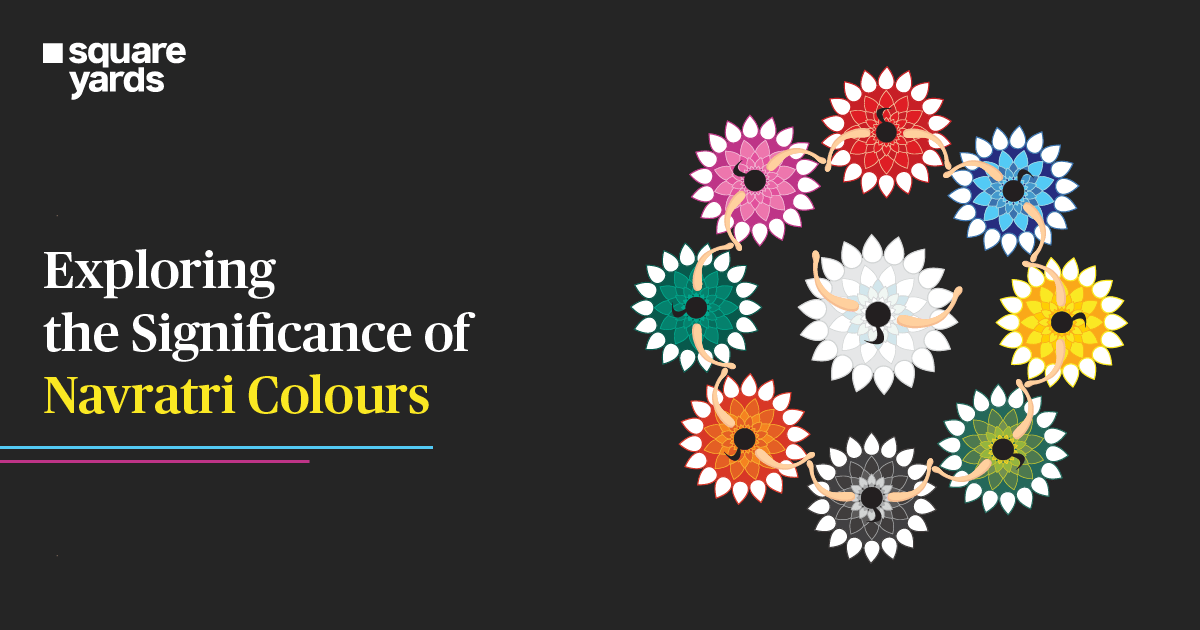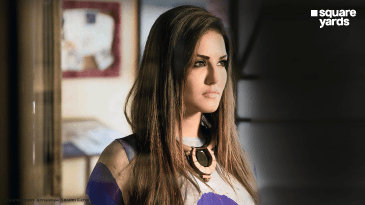Navratri is an auspicious and celebrated Hindu festival in India. It is a nine-day festival dedicated to the worship of Goddess Durga and her nine forms. Navratri means “nine nights” in Sanskrit, and each night is associated with a different colour representing another aspect of the Goddess.
After Sharada Navratri, which occurs in September or October, Chaitra Navratri is the second most widely celebrated. In the Gregorian calendar, Chaitra Navratri falls in either March or April.
It is marked by vibrant colours that hold deep significance. Each day of Navratri is associated with a specific colour, symbolising various aspects of spirituality and devotion. Each colour is believed to have a particular effect and is considered auspicious for that day. Wearing and using these colours can also enhance your mood, energy and devotion to the Goddess.
This article explores the nine Navratri colours for 2025, their significance, and ideas for Navratri celebrations beyond just wearing these colours.
Table of contents
- The Four Types of Navratri
- Spiritual Significance of the Navratri Colour Spectrum
- Navratri Colours – Navratri Mandir Decoration With Flowers
- Choose the Right Attire for Your Mandir Based on Navratri Colours
- Things to Do During Navratri Apart From Wearing Navratri Colours
- FAQ’s about Navratri Colours
The Four Types of Navratri
Here are the four different Navratri celebrations, the months of the year they are observed, and their seasonal names –
Sharadiya Navratri, Maha Navratri, or Ashwin Navratri
The most popular and widely celebrated Navratri falls in Ashwin (September or October). It coincides with the Durga Puja festival in eastern India, commemorating Goddess Durga’s victory over the demon Mahishasura. This Navratri ends with the Dussehra or Vijayadashami celebration on the tenth day, which marks the triumph of Lord Rama over Ravana.
Chaitra Navratri or Vasanta Navratri
It is the second-most significant Navratri, and it occurs in the Chaitra month, which takes place either in March or April. The spring season and the Hindu new year officially begin on this day. It also coincides with the Ram Navami festival on the ninth day, which celebrates the birth of Lord Rama.
Ashadha Navratri or Gayatri Navratri
A lesser-known Navratri falls in Ashadha (June or July). It is also called Gupta Navratra, as it is observed secretly by some sects of Hindus. It is mainly dedicated to Goddess Gayatri, the mother of all Vedas.
Magha Navratri
It is another lesser-known Navratri, which falls in Magha (January or February). It is also called Gupta Navratra, as it is observed secretly by some sects of Hindus. It is mainly dedicated to Goddess Saraswati, the Goddess of learning and arts.
Spiritual Significance of the Navratri Colour Spectrum
Here are the colours of Navratri and their significance –
Royal Blue
The colour royal blue is associated with regalness, wealth, and peace. It represents the strength and beauty of the Goddess Shailputri. She rides a bull and is the daughter of the Himalayan mountain. She has a lotus and a trident in her hands. Also, royal blue can promote tranquillity and peace in your home and mind.
Yellow
Yellow is the colour of happiness, joy and optimism. It symbolises the brightness and warmth of Goddess Brahmacharini. She is the embodiment of penance and austerity. She wears a white saree and holds a rosary and a water pot. Yellow can also fill your home with positive energy and cheerfulness.
Green
The colour green represents nature, growth, and fertility. It represents Goddess Chandraghanta’s bounty and wealth. She rides a tiger and has a crescent moon on her forehead. She has ten arms, a lotus in each hand, and various weaponry. Green may also add harmony and freshness to your home.
Grey
Grey is the colour of balance, neutrality and wisdom. It symbolises the strength and courage of Goddess Kushmanda. She is the creator of the universe and resides in the sun. She has eight arms and holds various weapons, a rosary, a lotus and a kamandalu. Grey can also help you stay grounded and humble in your home.
Orange
Orange is the colour of enthusiasm, creativity and passion. It symbolises the radiance and beauty of Goddess Skandamata. She is the mother of Skanda or Kartikeya, the commander-in-chief of the gods. She rides a lion and holds her son in one arm and a lotus in another hand. Orange can also inspire you to be more adventurous and expressive in your home.
White
The colour white symbolises innocence, tranquilly, and purity. It represents the calm and grace of the Goddess Katyayani. She rides a lion and is sage Katyayan’s daughter. With her four arms, she possesses a sword, a lotus, a shield, and a hand of benediction. Using white in your home can also promote solitude and relaxation.
Red
Red is the colour of love, passion and power. It symbolises the fierceness and courage of Goddess Kaalratri. She is the destroyer of evil and ignorance. She has a dark complexion and rides a donkey. She has four arms and holds a sword, a trident, a thunderbolt and a blessing hand. Red can also ignite your confidence and enthusiasm in your home.
Pink
The colour pink symbolises compassion, love, and beauty. It represents the grace and allure of the Goddess Mahagauri. She embodies simplicity and innocence. She mounts a bull while donning a white sari. She has four arms, each holding a blessing hand, a lotus, a drum, and a trident. Pink can also give your home a calming and romantic atmosphere.
Sky Blue
The colour sky blue symbolises inspiration, freedom, and creativity. Goddess Siddhidatri is worshipped, representing her majesty and happiness. She is the source of all siddhis, or supernatural abilities. On a lion, she rides while perched on a lotus. She has four arms, each holding a lotus, a discus, a conch shell, and a mace. You can meditate and unwind by using the colour sky blue at home.
Purple
The colour purple represents wealth, luxury, and royalty. Devotees are gifted with splendour and wealth when worshipping Navdurga while wearing purple. So don’t be afraid to wear a stunning purple outfit and seek the Goddess’ blessings.
Peacock Green
Peacock Green suggests originality and distinctiveness. Wearing this stunning bright green shade for Navratri will make you stand out. This colour radiates the traits such as sympathy, vitality, kindness, and distinction.
You can use these Navratri colours to celebrate this festival with joy and devotion. Mix and match these colours to create different combinations and styles for your clothes and home decor. By following these colours, you can also attract the blessings of Goddess Durga and her nine forms in your life.
| Day | Chaitra Navratri Colours | Date | |
| Day 1 – Pratipada | Royal Blue | March 22, 2023 | Wednesday |
| Day 2 – Dwitiya | Yellow | March 23, 2023 | Thursday |
| Day 3 – Tritiya | Green | March 24, 2023 | Friday |
| Day 4 – Chaturthi | Grey | March 25, 2023 | Saturday |
| Day 5 – Panchami | Orange | March 26, 2023 | Sunday |
| Day 6 – Shashthi | White | March 27, 2023 | Monday |
| Day 7 – Saptami | Red | March 28, 2023 | Tuesday |
| Day 8 – Ashtami | Sky Blue | March 29, 2023 | Wednesday |
| Day 9 – Navami | Pink | March 30, 2023 | Thursday |
| Day | Ashwin Sharad Navratri Colours | Date | |
| Day 1 – Pratipada | Orange | October 15, 2023 | Sunday |
| Day 2 – Dwitiya | White | October 16, 2023 | Monday |
| Day 3 – Tritiya | Red | October 17, 2023 | Tuesday |
| Day 4 – Chaturthi | Royal Blue | October 18, 2023 | Wednesday |
| Day 5 – Panchami | Yellow | October 19, 2023 | Thursday |
| Day 6 – Shashthi | Green | October 20, 2023 | Friday |
| Day 7 – Saptami | Grey | October 21, 2023 | Saturday |
| Day 8 – Ashtami | Purple | October 22, 2023 | Sunday |
| Day 9 – Navami | Peacock Green | October 23, 2023 | Monday |
Navratri Colours – Navratri Mandir Decoration With Flowers
The festival of Navratri is celebrated twice a year, with Chaitra Navratri marking the beginning of the Hindu New Year. During this time, devotees adorn their homes and temples with vibrant decorations, especially flowers, to create a divine ambience. Yellow and orange marigolds, roses, blue orchids, mango leaves, white tulips, and jasmine are commonly used for Navratri mandir decoration, enhancing the spiritual atmosphere and invoking positive energy.
Choose the Right Attire for Your Mandir Based on Navratri Colours
To improve your Navratri mandir decorations, decorate your mandir idols in various Navratri colours. Depending on the day, you can dress up the Goddess in different Indian attires such as lehenga, veil (dupatta), saree, and more in the designated colours and other accessories.
Check Out the Best Properties to Buy in Various Cities in India this Festive Season
Things to Do During Navratri Apart From Wearing Navratri Colours
Wearing the specified colours is simply one aspect of Navratri. It is a period of devotion, festivities, and spiritual reflection. Most Hindus don a different colour each day of Navratri to represent the Goddess’ various facets and energy. Nonetheless, to observe Navratri with joy and devotion, one can do many other things. Here are a few activities to enhance your Navratri experience:
Fasting
During Navratri, most devotees observe abstinence to purify their bodies and minds. You can fast by eating only particular foods or without food entirely.
Keeping a fast for some or all festival days is another everyday activity during Navratri. Fasting purifies the body and mind while expressing devotion and thanks to the Goddess. Depending on your location and heritage, there are several guidelines and traditions for fasting during Navratri. While some people only consume fruits, milk, and water, others avoid all foods and beverages. Others consume only sattvic foods devoid of oil or spices, while some steer clear of grains, salt, onion, garlic, and alcohol.
Garba and Dandiya Raas
Participating in the Gujarati folk dances – Garba and Dandiya Raas is another enjoyable activity during Navratri. Women wear vibrant costumes to perform the Garba and dance in circles around a clay pot with a lamp symbolising the Goddess.
Men and women dance the dandiya while holding wooden sticks, symbolising the Goddess’s swords. These dances are performed to upbeat music, creating a joyful vibe. You can attend garba and dandiya programmes hosted by different communities and groups or plan your own at home.
Read Scriptures and Listen to Devotional Songs
Participate in bhajans, prayers, and devotional singing for the Goddess. Light incense, present flowers, and recite mantras to create a peaceful environment.
Reading holy texts and listening to devotional music that exalts the Goddess and her works are two other ways to observe Navratri. You can read the Ramayana, Durga Saptashati, Devi Mahatmyam, and Devi Bhagavatam, which tell the tales of the Goddess and her followers. Additionally, you can listen to religious music to feel an intense affection and adoration for the Goddess when you listen to these tunes.
Perform Puja and Aarti
Puja and aarti for Goddess Durga and her nine forms are among the most crucial things to undertake during Navratri. You can set up an altar at your home with an idol or a picture of the Goddess, along with flowers, incense, lamps, fruits and sweets. You can also recite mantras, hymns and prayers for each form of the Goddess, such as Durga Chalisa, Durga Saptashati and Devi Kavach. You can also join community pujas and aartis at temples or pandals.
Donate to Charity and Feed the Poor
Another noble thing to do during Navratri is to donate to charity and feed the less unfortunate. You can donate money, clothes, food or other items to various organisations that work for the welfare of those in need. You can also feed poor people in your locality, temples, or shelters. You can also invite nine young girls to your home and offer them food and gifts to symbolise worshipping the Goddess. It will help you earn the Goddess’s blessings and spread happiness.
Community Celebrations
Join community events and celebrations, such as Navratri pandals or cultural programs, to experience the collective spirit of the festival.
You can celebrate this festival with joy and devotion and experience the Goddess’s grace and power by doing these things.
FAQ’s about Navratri Colours
Q1. Which colour to wear on the first day of Navratri?
The Navratri colour for the first day is determined depending on the calendar and the colour designated as per the Goddesses. Orange is the colour for the first day of Sharada Navratri, celebrated on October 15, 2023.
Q2. Who are the 9 Goddesses of Navratri?
The 9 Goddesses of Navratri are Shailputri, Navdurga, Siddhidatri, Kaalratri, Skandamata, Kushmanda, Chandraghanta, Brahmacharini, and Katyayani.
Q3. How are Navratri colours decided?
The day, power, and features of the Goddesses are considered when selecting the Navratri colours.


















































